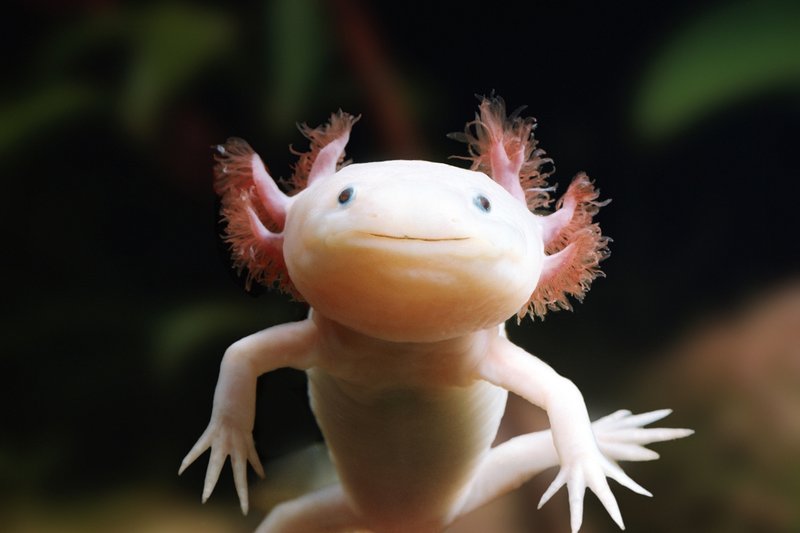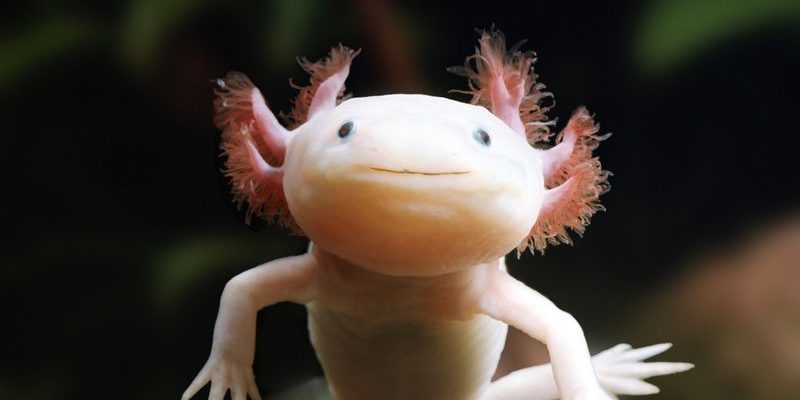
Living in the lakes of Mexico, particularly Lake Xochimilco, axolotls have developed fascinating traits that allow them to survive and even regenerate lost body parts. You might think of them as the superheroes of the amphibian world. Let’s dive in and explore the amazing adaptations that make the axolotl a survivor in a challenging and ever-changing habitat.
Regeneration: Nature’s Marvel
One of the most jaw-dropping adaptations of the axolotl is its ability to regenerate lost body parts. Imagine if you could grow back a finger or even a whole limb if you accidentally lost it! Axolotls can regenerate limbs, their spinal cord, and even parts of their heart and brain—how cool is that?
So, how does this work? When an axolotl loses a limb, a blastema forms at the injury site. This special structure contains cells that can transform into whatever type of tissue is needed, whether it’s muscle, nerve, or skin. Basically, they have a built-in repair kit! Scientists are eager to study this incredible process, as it could lead to advancements in regenerative medicine for humans. You might be wondering how they pull this off without a hitch. It turns out that the axolotl’s immune system plays a crucial role, helping to prevent scarring and promoting healthy tissue growth.
In their natural habitat, the ability to regenerate is super important for survival. With predators lurking around, losing a limb might seem like a major setback, but for axolotls, it’s just a temporary hiccup. They can continue to live and thrive while waiting for their body to work its magic and grow back what it lost.
Neoteny: Staying Young at Heart
Another unique adaptation of the axolotl is its neoteny—a fancy term that means it retains juvenile features even into adulthood. Unlike most amphibians that go through a complete metamorphosis from tadpoles to adults, axolotls skip the whole land-life phase and stay in their aquatic form. It’s like being a kid forever, and honestly, who wouldn’t want that?
This adaptation comes with some perks. By remaining aquatic, axolotls can continue to live in a water-only environment, which suits them just fine. They possess external gills, which are those feathery appendages on their heads that help them breathe underwater. The axolotl’s young appearance makes it charming, but it also means that it never has to face the challenges of life on land, like finding suitable food or avoiding terrestrial predators.
Neoteny also plays a crucial role in their habitat. In the wild, where water levels fluctuate, staying aquatic helps axolotls adapt to changing conditions. They can often be found in shallow waters near floating vegetation, where they hunt for worms, small fish, and other delicacies. By embracing their “inner child,” axolotls can thrive in their niche without the stress of metamorphosis.
Adaptations for Survival: Breathing & Feeding
Axolotls come equipped with some nifty adaptations that help them thrive in their aquatic homes. For starters, their external gills are not just for show. These feathery structures allow them to breathe easily and efficiently in water. With gills that can absorb oxygen directly from the water, they don’t need to surface as often as other amphibians, making them agile hunters in their habitat.
Speaking of hunting, axolotls have another clever adaptation: their unique feeding habits. They are opportunistic feeders, meaning they don’t have a picky diet. They’ll chow down on worms, small fish, and even other amphibians. The axolotl’s wide mouth and flexible jaw help it gulp down prey quickly. This adaptability in their diet means they can survive in areas where food might be scarce or inconsistent.
Additionally, their ability to blend into their environment helps them avoid predators. Their skin color can vary from dark gray to lighter shades, allowing them to camouflage against the murky waters of their habitat. With these skills in their back pocket, axolotls can hunt efficiently while staying safe from bigger fish and birds.
Resilience in Changing Habitats
The axolotl’s ability to adapt goes beyond physical traits—it’s about survival in a world that’s constantly changing. Unfortunately, their natural lakes are facing serious threats from pollution, habitat loss, and invasive species. Yet, axolotls have shown incredible resilience. They can tolerate lower oxygen levels in the water better than many other species. This ability is crucial when water quality declines due to human activity.
Their resilience has led to some interesting studies and conservation efforts. Scientists are working on breeding programs in captivity to help maintain healthy populations outside their natural habitat. You might be curious about how these efforts translate into real-world change. By carefully monitoring and maintaining genetic diversity in breeding programs, researchers aim to boost the chances of survival for axolotls, should their natural habitats continue to decline.
Even in the face of challenges, axolotls remind us that adaptability and resilience are key to survival. Their ability to thrive in the face of adverse conditions is a powerful lesson for us all.
The Role of Scientists: Understanding the Axolotl
An interesting aspect of axolotls is their appeal in scientific research. They’re often studied for their remarkable regenerative abilities, making them popular in labs around the world. Researchers hope to unlock the secrets of their regeneration to better understand human healing processes. It’s a bit like being a superhero in the lab—scientists hope to learn from their superpowers!
Let me explain why this matters. By understanding the mechanisms behind regeneration in axolotls, scientists could pave the way for breakthrough treatments in medicine—think about regenerative therapies for injuries or degenerative diseases. Imagine a future where we could regrow damaged organs or regenerate tissues. The axolotl’s fascinating biology could lead to life-altering advancements.
In addition to their regenerative capabilities, axolotls also serve as indicators of environmental health. Because they’re sensitive to changes in water quality, researchers use them to monitor the ecosystem’s health. Their presence—or absence—can provide vital clues about the state of the habitats they live in.
Conservation: Protecting the Axolotl’s Future
Despite their incredible adaptations, axolotls face significant threats that require immediate attention. Their natural habitat is rapidly declining due to urbanization, pollution, and the introduction of invasive species. Conservation efforts are underway, but there’s still much work to be done.
Organizations and researchers are slowly raising awareness about the plight of the axolotl. Local initiatives focus on habitat restoration and combating pollution in their native waters. You might be wondering what you can do to help. Supporting organizations dedicated to wildlife conservation, educating yourself and others about the importance of preserving habitats, and advocating for the protection of ecosystems can all make a positive difference.
By ensuring that their natural environments are safeguarded, we’re not just protecting a unique species—we’re also preserving a fascinating part of our planet’s biodiversity. With continued efforts and awareness, there’s hope that the axolotl can continue to thrive and inspire future generations.
In conclusion, the axolotl is a remarkable example of nature’s ingenuity. From its regenerative abilities to its resilient lifestyle, this “Mexican walking fish” showcases a range of adaptations that help it on its journey through life. As we learn more about this extraordinary creature, let’s not forget the importance of protecting its home and preserving its incredible story for the future.

